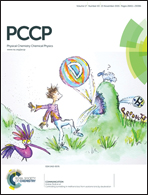A simple aqueous electrochemical method to synthesize TiO2 nanoparticles†
Abstract
Here, a simple and rapid electrochemical approach to synthesize TiO2 nanoparticles in aqueous solution is reported. This method consists in the electro-oxidation of titanium foil in a tetrabutylammonium bromide aqueous solution, which acts as both an electrolyte and a surfactant. Amorphous TiO2 particles in the nanoscale (∼5 nm), well dispersed in aqueous solution, were directly formed by applying low current densities in a short reaction time. It was demonstrated that several experimental parameters influence the reaction yield; an increase in the current, temperature and reaction time augments the quantity of the obtained material. Then, the amorphous nanoparticles were completely crystallized into a pure anatase phase by thermal treatment under an air atmosphere as analyzed by X-ray diffraction and Raman spectroscopy. Besides, the size of the nanoparticles increased to approximately 12 nm in the calcination process. The band gap energies of the resulting TiO2 anatase nanoparticles were determined by diffuse reflectance measurements according to the Kubelka Munk theory, revealing low values between 2.95 and 3.10 eV. Therefore, the results indicate the success of this method to create TiO2 nanoparticles in aqueous medium with good optical properties.


 Please wait while we load your content...
Please wait while we load your content...